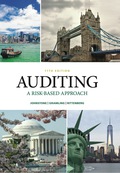
EBK AUDITING: A RISK BASED-APPROACH
11th Edition
ISBN: 9781337670203
Author: RITTENBERG
Publisher: YUZU
expand_more
expand_more
format_list_bulleted
Question
Chapter 9, Problem 24CYBK
To determine
Introduction:
Revenue cycle is a process or an activity of a company that starts from making of the goods or services and ends with receipt of cash for making sales of goods or services.
To select:
Choose the right answer among the given options that stands true with the given condition.
Expert Solution & Answer
Want to see the full answer?
Check out a sample textbook solution
Students have asked these similar questions
What percentage change in sales occurs if profit
What is income under full costing?
Hello tutor solve this question accounting
Chapter 9 Solutions
EBK AUDITING: A RISK BASED-APPROACH
Ch. 9 - In the revenue cycle, the most significant...Ch. 9 - Which of the following statements is true...Ch. 9 - Prob. 4CYBKCh. 9 - Prob. 7CYBKCh. 9 - Prob. 8CYBKCh. 9 - Prob. 9CYBKCh. 9 - Prob. 10CYBKCh. 9 - Prob. 11CYBKCh. 9 - Prob. 12CYBKCh. 9 - Prob. 13CYBK
Ch. 9 - Prob. 14CYBKCh. 9 - Prob. 15CYBKCh. 9 - Prob. 16CYBKCh. 9 - Prob. 17CYBKCh. 9 - Prob. 18CYBKCh. 9 - Which of the following statements is false...Ch. 9 - Prob. 20CYBKCh. 9 - Prob. 22CYBKCh. 9 - Prob. 23CYBKCh. 9 - Prob. 24CYBKCh. 9 - Prob. 25CYBKCh. 9 - Prob. 26CYBKCh. 9 - Prob. 27CYBKCh. 9 - Prob. 28CYBKCh. 9 - Prob. 29CYBKCh. 9 - Prob. 30CYBKCh. 9 - Prob. 31CYBKCh. 9 - Prob. 32CYBKCh. 9 - Refer to Exhibit 9.1. Which accounts are relevant...Ch. 9 - Prob. 2RQSCCh. 9 - Prob. 3RQSCCh. 9 - An important task ¡n the audit of the revenue...Ch. 9 - Prob. 5RQSCCh. 9 - Prob. 6RQSCCh. 9 - Prob. 7RQSCCh. 9 - Prob. 8RQSCCh. 9 - Prob. 9RQSCCh. 9 - Prob. 10RQSCCh. 9 - Prob. 11RQSCCh. 9 - Prob. 12RQSCCh. 9 - Prob. 13RQSCCh. 9 - Prob. 14RQSCCh. 9 - Prob. 15RQSCCh. 9 - Stainless Steel Specialties (SSS) is a...Ch. 9 - Prob. 17RQSCCh. 9 - Prob. 18RQSCCh. 9 - Prob. 19RQSCCh. 9 - Prob. 20RQSCCh. 9 - Prob. 21RQSCCh. 9 - Prob. 22RQSCCh. 9 - Prob. 23RQSCCh. 9 - Prob. 24RQSCCh. 9 - Prob. 25RQSCCh. 9 - Prob. 26RQSCCh. 9 - Prob. 27RQSCCh. 9 - Prob. 28RQSCCh. 9 - Prob. 29RQSCCh. 9 - Prob. 30RQSCCh. 9 - Prob. 31RQSCCh. 9 - Prob. 32RQSCCh. 9 - Prob. 33RQSCCh. 9 - Prob. 34RQSCCh. 9 - Prob. 35RQSCCh. 9 - Prob. 36RQSCCh. 9 - Prob. 37RQSCCh. 9 - Prob. 38RQSCCh. 9 - Prob. 39RQSCCh. 9 - Read the following scenario about Strang...Ch. 9 - Prob. 41RQSCCh. 9 - Prob. 42RQSCCh. 9 - ZYNGA (LO Z 3, 4, 5, 6, 8) Refer to the Why It...Ch. 9 - UTSTARCOM, INC. (LO 2, 3, 4, 5, 6, 8) UTStarcom is...Ch. 9 - Prob. 47FFCh. 9 - Prob. 48FFCh. 9 - Prob. 55DAUA
Knowledge Booster
Similar questions
- Define in detail the following in relation to Organizational Ethics. The Ethical Culture of an organization. Define these Five Signs of Ethical Collapse a) Pressure to maintain the numbers b) Fear of reprisals c) Loyalty to the boss d) Innovations e) Goodness in some areas, atones for evil in othersarrow_forwardCalculate the stock in the beginningarrow_forwardI need help with this problem and accountingarrow_forward
- Provide correct solution and accountingarrow_forwardWhat is its DOL? Accounting questionarrow_forwardThe following data were selected from the records of Fluwars Company for the year ended December 31, current year: Balances at January 1, current year: Accounts receivable (various customers) $ 111,500 Allowance for doubtful accounts 11,200 The company sold merchandise for cash and on open account with credit terms 1/10, n/30, without a right of return. The following transactions occurred during the current year: Sold merchandise for cash, $252,000. Sold merchandise to Abbey Corp; invoice amount, $36,000. Sold merchandise to Brown Company; invoice amount, $47,600. Abbey paid the invoice in (b) within the discount period. Sold merchandise to Cavendish Inc.; invoice amount, $50,000. Collected $113,100 cash from customers for credit sales made during the year, all within the discount periods. Brown paid its account in full within the discount period. Sold merchandise to Decca Corporation; invoice amount, $42,400. Cavendish paid its account in full after the…arrow_forward
arrow_back_ios
SEE MORE QUESTIONS
arrow_forward_ios
Recommended textbooks for you
 Auditing: A Risk Based-Approach (MindTap Course L...AccountingISBN:9781337619455Author:Karla M Johnstone, Audrey A. Gramling, Larry E. RittenbergPublisher:Cengage Learning
Auditing: A Risk Based-Approach (MindTap Course L...AccountingISBN:9781337619455Author:Karla M Johnstone, Audrey A. Gramling, Larry E. RittenbergPublisher:Cengage Learning Auditing: A Risk Based-Approach to Conducting a Q...AccountingISBN:9781305080577Author:Karla M Johnstone, Audrey A. Gramling, Larry E. RittenbergPublisher:South-Western College Pub
Auditing: A Risk Based-Approach to Conducting a Q...AccountingISBN:9781305080577Author:Karla M Johnstone, Audrey A. Gramling, Larry E. RittenbergPublisher:South-Western College Pub

Auditing: A Risk Based-Approach (MindTap Course L...
Accounting
ISBN:9781337619455
Author:Karla M Johnstone, Audrey A. Gramling, Larry E. Rittenberg
Publisher:Cengage Learning

Auditing: A Risk Based-Approach to Conducting a Q...
Accounting
ISBN:9781305080577
Author:Karla M Johnstone, Audrey A. Gramling, Larry E. Rittenberg
Publisher:South-Western College Pub